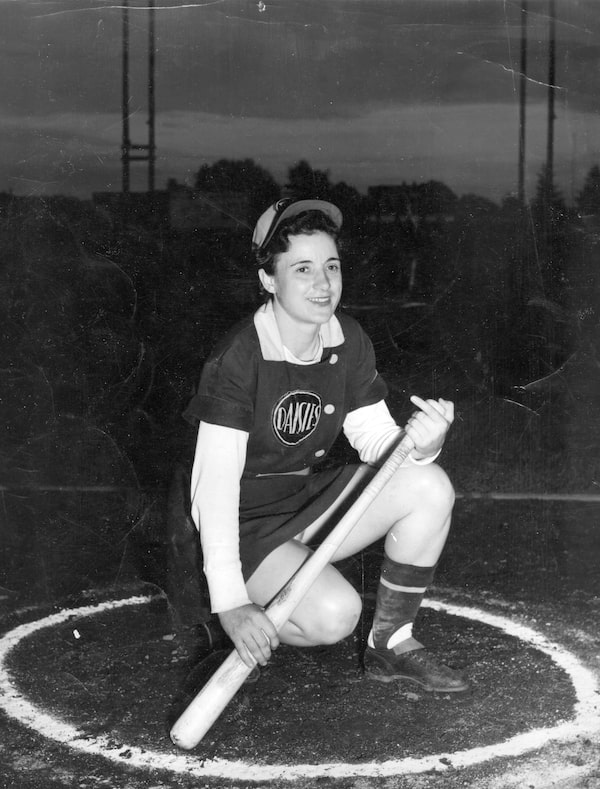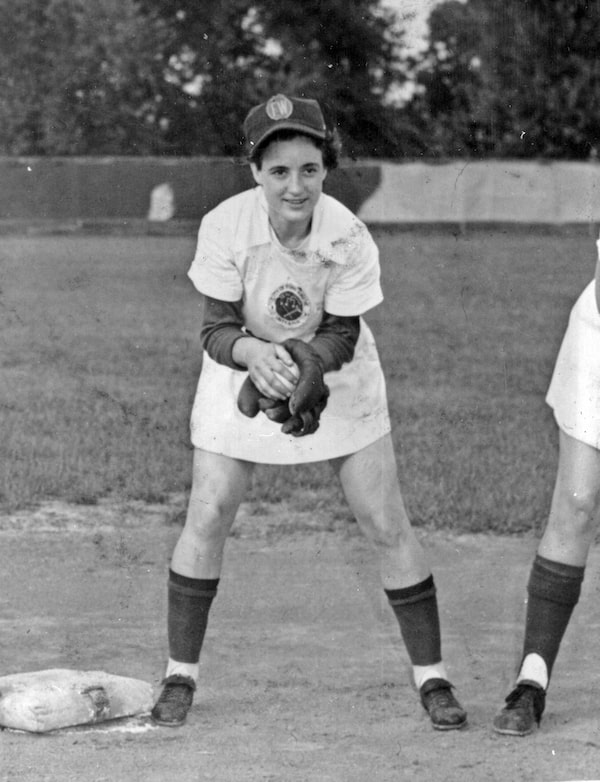
Evie Moroz in the uniform of the Fort Wayne Daisies of Indiana of the All American Girls Baseball League. Ms. Moroz died in Winnipeg on Feb. 3. She was 97.Manitoba Sports Hall of Fame & Museum
Evie Moroz committed an error in her first game of professional baseball, throwing the ball away on a rundown play. She feared being cut from her Wisconsin team, which would mean an embarrassing return to her teacher’s post in a northern Manitoba mining town.
Instead, she spent six summers crisscrossing the American Midwest in the All-American Girls Professional Baseball League. A second baseman, she was named a league all-star three times.
“We were colourful and skilled, but they still wanted us to be feminine,” she said in 1982. “Some people figured we had no business playing boys’ games.”
Her playing career ended after the 1951 season when she married and started a family, while the league itself folded after the 1954 campaign. The trailblazing players pursued careers and became homemakers, their exploits mostly forgotten for decades until the release of the 1992 Hollywood movie A League of Their Own, starring Madonna, Geena Davis and Tom Hanks.
Ms. Moroz died in Winnipeg on Feb. 3. She was 97.

Members of the 1946 Muskegon Lassies pose for a team portrait.Manitoba Sports Hall of Fame & Museum
A superb athlete, the 5-foot-3, 135-pound dynamo was called the Tyndall Tornado, a nickname she gained as the best women’s hockey player in Manitoba. Miss Hockey, as she was also known, starred on softball diamonds, too, earning a headline describing her as the “Beltin’ Bambina.”
Evelyn Florence Wawryshyn (pronounced war-ish-inn) was born on Nov. 11, 1924, in Tyndall, a village about 40 kilometres northeast of Winnipeg known for the rock produced from its limestone quarry. She was one of four children born to the former Mae Beatrice Weselak and Theodore George (Ted) Wawryshyn, owner of a general store who served for two years during the Depression as reeve of the rural municipality of Brokenhead.
A self-described tomboy, the girl spent hours practising alone, catching an India rubber ball thrown against her house. An older brother encouraged her to play baseball and she was soon fielding at the key position of shortstop while attending an elementary school in which she would recall there were not many boys.
After moving to Winnipeg to complete teacher training at the Provincial Normal School, she joined the Canadian Ukrainian Athletic Club Blues fastball team. Her steady fielding and power hitting helped make her a fan favourite in games at Osborne Stadium.
If she had been born a boy, wrote Winnipeg Tribune columnist Tony Allan, “she might be worth $50,000 in today’s baseball market, and the stands would be filled with major league scouts.”
“Evelyn can powder the ball,” he added. “She’s the home-run queen of the loop. In the field, she looks even more like a ball player, and has the shortstop chore figured to a T. In last night’s game, … Wawryshyn gobbled up fly balls in deep short and back of third, stabbed a hot liner for a double play that ended the game. She showed an uncanny ability to be in the right spot at the right time.”
Jack Matheson, another Tribune sportswriter, was scouting on behalf of a new professional league for women. After one game, he offered to sign her, but she refused, never having heard of the league. A year later, while she was holding a $1,000-a-year job as a teacher at the Main School in Flin Flon, 750 kilometres northwest of Winnipeg, a telegram arrived from the scout offering her $50 a week in the summer to play baseball. This time, she said yes to a circuit known as the “glamour league.”
The players were not allowed to wear pants in public and were accompanied by chaperones. In the league’s first seasons, they also had to attend classes on etiquette.
“Look like women,” she once said. “Play like men.”
She was assigned to the Kenosha (Wis.) Comets and later played for the Muskegon (Mich.) Lassies, Springfield (Ill.) Sallies, and the Fort Wayne (Ind.) Daisies. In 1950, she hit .311 for the Daisies with 13 doubles, two triples and her only career home run. She also had 50 runs batted-in and 65 stolen bases in 104 games. A .266 career batting average was 15th best in league history.
One of her favourite memories of playing in the league was attending spring training in Cuba in 1947. The players travelled by train to Miami before boarding planes for the short flight to Havana. They stayed at the swank Seville-Biltmore Hotel, where they were forbidden to use the elevator as the coaches wanted them to get into shape by climbing stairs. They danced on the roof of the Hotel Plaza, hung out at a bar called Sloppy Joe’s, and were filmed by Fox Newsreel parading down the famous steps at the University of Havana.
A fortnight in Havana culminated in exhibition games against Cuban women’s all-stars at the eight-month-old Gran Estadio de la Habana (now known as Estadio Latinoamericano). It is said the women attracted larger crowds than did the spring training of the recently departed Brooklyn Dodgers, featuring rookie Jackie Robinson.

A second baseman, Ms. Moroz was named a league all-star three times in the All-American Girls Professional Baseball League.Manitoba Sports Hall of Fame & Museum
After the 1951 season, she married John Litwin, a baseball fan from a family of hotel food workers. Her new life ended abruptly when her husband died of a heart attack while shovelling snow, just 10 days after the birth of their second child. The widow returned to Tyndall, where she operated a chip stand with her brother, Bob Warren, who, like some others in the family, anglicized his Ukrainian family name.
In 1960, she married school principal Henry Moroz with whom she had four more children. She worked for the parks and recreation department in Winnipeg.
Her athletic achievements included guiding her Winnipeg All-Stars hockey team to the Lady Bessborough Trophy as Dominion champions in 1950. She scored four goals in the final game, a 7-3 victory over the Port Arthur (Ont.) Bombers. She was the top scorer in Manitoba women’s hockey as a star player with the Varsity Doodlebugs. As well, she won a provincial basketball championship with a Flin Flon team in 1946 and, earlier, had been Northeastern Manitoba’s track-and-field champion.
In 1998, the Canadian Baseball Hall of Fame in St. Marys, Ont., inducted all 68 Canadians who had played in the All-American league. Ms. Moroz has also been inducted into the Manitoba Sports Hall of Fame (1992), the Manitoba Baseball Hall of Fame (1998), the Manitoba Softball Hall of Fame (2004), and the Ukrainian Sports Hall of Fame in Horsham, Pa. (2018).
Throughout her life, Ms. Moroz maintained several superstitions from her athletic days, notably always putting her left shoe on first.
She leaves six children, 11 grandchildren, and seven great-grandchildren. She was predeceased by her husbands, John Litwin, who died in 1954, aged 35, and Henry Moroz, her husband of 48 years, who died in 2008, aged 83.
In a 1948 game at Waukegan, Ill., Ms. Moroz ran into the outfield in pursuit of a fly ball, even as her teammate, outfielder June Emerson, of Moose Jaw, Sask., raced in. The second baseman slowed to allow her teammate to make the catch.
“She lost it in the lights,” Ms. Moroz told the Winnipeg Sun in 1992, “and of course it hit her in the head and it bounced right up again into the air and I made the catch.”
The umpire ruled the batter out. Ms. Moroz was credited with the put out, while her hapless teammate got an assist and, likely, a bruise.